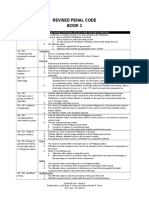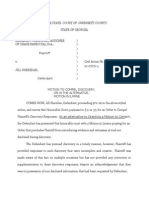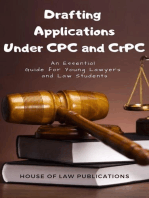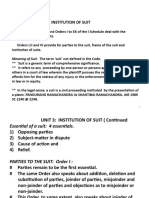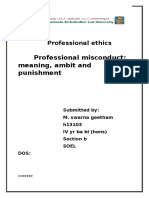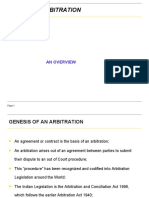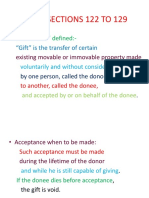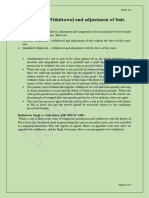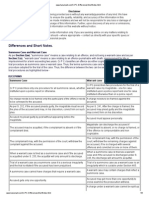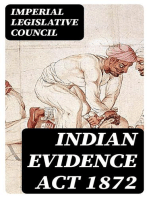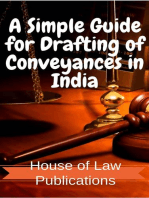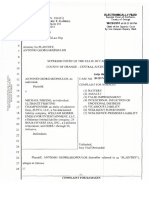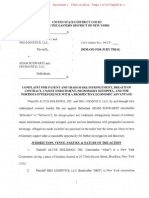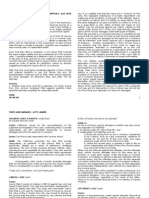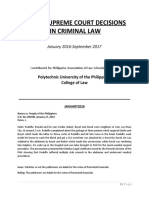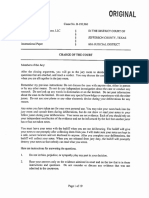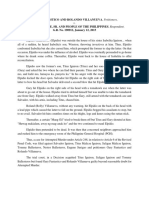0%(1)0% found this document useful (1 vote)
137 viewsPlaint and WS
Plaint and WS
Uploaded by
Aditya Singh Chouhan(1) A plaint is a written statement filed by the plaintiff in a civil suit that describes the cause of action and seeks a remedy or relief from the court.
(2) It must include specific details like the names and addresses of the plaintiff and defendant, facts of the case, claim, court with jurisdiction, and verification by the plaintiff.
(3) There are specific sections of the Code of Civil Procedure and orders that must be followed when drafting a plaint or written statement, which includes details of parties, framing of the suit, pleadings, and necessary contents.
Copyright:
© All Rights Reserved
Available Formats
Download as DOCX, PDF, TXT or read online from Scribd
Plaint and WS
Plaint and WS
Uploaded by
Aditya Singh Chouhan0%(1)0% found this document useful (1 vote)
137 views4 pages(1) A plaint is a written statement filed by the plaintiff in a civil suit that describes the cause of action and seeks a remedy or relief from the court.
(2) It must include specific details like the names and addresses of the plaintiff and defendant, facts of the case, claim, court with jurisdiction, and verification by the plaintiff.
(3) There are specific sections of the Code of Civil Procedure and orders that must be followed when drafting a plaint or written statement, which includes details of parties, framing of the suit, pleadings, and necessary contents.
Copyright
© © All Rights Reserved
Available Formats
DOCX, PDF, TXT or read online from Scribd
Share this document
Did you find this document useful?
Is this content inappropriate?
(1) A plaint is a written statement filed by the plaintiff in a civil suit that describes the cause of action and seeks a remedy or relief from the court.
(2) It must include specific details like the names and addresses of the plaintiff and defendant, facts of the case, claim, court with jurisdiction, and verification by the plaintiff.
(3) There are specific sections of the Code of Civil Procedure and orders that must be followed when drafting a plaint or written statement, which includes details of parties, framing of the suit, pleadings, and necessary contents.
Copyright:
© All Rights Reserved
Available Formats
Download as DOCX, PDF, TXT or read online from Scribd
Download as docx, pdf, or txt
0%(1)0% found this document useful (1 vote)
137 views4 pagesPlaint and WS
Plaint and WS
Uploaded by
Aditya Singh Chouhan(1) A plaint is a written statement filed by the plaintiff in a civil suit that describes the cause of action and seeks a remedy or relief from the court.
(2) It must include specific details like the names and addresses of the plaintiff and defendant, facts of the case, claim, court with jurisdiction, and verification by the plaintiff.
(3) There are specific sections of the Code of Civil Procedure and orders that must be followed when drafting a plaint or written statement, which includes details of parties, framing of the suit, pleadings, and necessary contents.
Copyright:
© All Rights Reserved
Available Formats
Download as DOCX, PDF, TXT or read online from Scribd
Download as docx, pdf, or txt
You are on page 1of 4
What is Plaint?
Plaint is written statement of plaintiff’s claim. Through plaint, plaintiff describes his
cause of action and other necessary particulars to seek remedy from court for redressed of
his grievances.
In English practice, a private memorial tendered in open court to the judge, where the
party injured sets forth his cause of action.
Origin of word of Plaint
Middle English: from Old French plainte, feminine past participle of plaindre
‘complain’, or from Old French plaint, from Latin planctus ‘beating of the breast’.
Before drafting a Pliant/Written Statement, especially the following Sections of the
Code of Civil Procedure, 1908 should be followed:
Section 15: Courts in which suits to be instituted
Section 16: Suits to be instituted where subject-matter situate
Section 17: for immovable property situate within jurisdiction of different Courts
Section 18: of institution of suit where local limits of jurisdiction of Courts are uncertain
Section 19: Suits for compensation for wrongs to person or movables
Section 20: Other suits to be instituted where defendants arises or cause of action arises
Section 26: Institution of suits
Before drafting a Pliant/Written Statement, especially the following Orders of the
Code of Civil Procedure, 1908 should be followed:
Order 1: Parties to Suits
Order 2: Frame of Suit
Order 3: Recognized Agents and Pleaders
Order 4: Institution of Suit
Order 6: Pleadings Generally
Order 7: Plaint
Order 8: Written Statement and Set-Off
Continue Page-2
Page-2
Necessary Contents of Plaint
Followings are the necessary contents of plaint;
(i) Plaint should contain name of that court in which suit is brought.
(ii) Plaint should contain name, description and residence of plaintiff.
(iii) Plaint should contain name, description and residence of defendant.
(iv) When plaintiff or defendant is minor or person of unsound mind, plaint should
contain a statement to that effect.
(v) Plaint should contain those facts, which have constituted cause of action. In
addition to this, it should also be described in plaint when cause of action has
arisen.
(vi) Plaint should contain those facts, which show the court has jurisdiction.
(vii) Plaint should contain that relief, which plaintiff claims.
(viii) When plaintiff has allowed set off or has relinquished a portion of his claim,
plaint should contain that amount, which has been so allowed or so
relinquished.
(ix) Plaint should contain statement of value of subject-matter of suit not only for
purpose of jurisdiction, but also for purpose of court-fees.
(x) Plaint should contain plaintiff’s verification on oath.
Parts of Plaint
The Plaint has got 8 parts:
1. Cause Title
2. Statements showing cause of action
3. Particular date of cause of action
Statement about Jurisdiction
4. Relief or Prayer
5. Valuation of Statement
6. Schedule in the Case of Immovable Property
7. Verification
Parts of Written Statement (WS)
The Written Statement has got 5 parts:
1. Cause Title
2. Objection as to point of law3
3. Para wise denial
4. Actual Fact
5. Verification
Continue Page-3
7 (seven) Books:
Before drafting a Pliant/Written Statement, especially the following 7 (seven) the Books
(Act/Order) should be followed:
1. The Limitation Act, 1963
2. The Suit Valuation Act, 1887
3. The Court Fees Act, 1870
4. The Code of Civil Procedure, 1908
5. The Civil Rules and Orders (CRO)
6. The Civil Courts Act, 1977.
7. Relevant Laws like The Specific Relief Act, 1963 or others
Notes:
For Pre-emption, Petition is to be filed and it ends with an Order, but the Pre-
emption under Muslim Law is a suit. In that case, plaint is filed and ends with
decree.
In the matter of Criminal cases all are Petition, but in the matter of Civil all are
Suit.
Particulars of a Plaint for Filing
1. Plaint
2. Firisti Form with all supporting Documents with date
3. Process Fee
4. A copy of Plaint is to submit for each Defendant
5. Summons, 3 Copies for each Defendants
(a) Served by Dasti
(b) Served by Post Office Copy (Reserved in the office with paint)
6. Judicial Stamp
7. Vakalatnama
Particulars of a Written Statement (WS) for Filing
1. Written Statement
2. Firisti Form with all supporting Documents with date
3. 3 copy of Written Statement for each Plaintiff
4. Vakalatnama
Continue Page-4
Amendment of Pleadings
Amendment of pleading is possible in any stage of the suit with the permission of the
Court. Order VI, Rule 17 of the Code of Civil Procedure, 1998. Even amendment of
Pleading is also possible in appeal stage, but it must be before delivery of judgment.
Conclusion
To conclude, it can be stated that plaint plays important role throughout whole trial of any
civil suit. It is admitted principle that no plaintiff can go beyond his plaint. Therefore, no
plaintiff can demand what is not claimed in his plaint. Similarly, no plaintiff can produce
any evidence, which is beyond his plaint.
You might also like
- Gov Uscourts DCD 258148 165 0Document7 pagesGov Uscourts DCD 258148 165 0Aaron Parnas100% (1)
- RPC Book 2 and Special Penal Laws ElementsDocument35 pagesRPC Book 2 and Special Penal Laws ElementsBien Lelay94% (16)
- Simple Guide for Drafting of Civil Suits in IndiaFrom EverandSimple Guide for Drafting of Civil Suits in IndiaRating: 4.5 out of 5 stars4.5/5 (4)
- CASE COMMENT On RAM CHANDRA VS STATE OF HARYANA .Docx Evidence LawDocument3 pagesCASE COMMENT On RAM CHANDRA VS STATE OF HARYANA .Docx Evidence LawKanchan VermaNo ratings yet
- Defendant's Motion To Compel or in The Alternative Motion in LimineDocument24 pagesDefendant's Motion To Compel or in The Alternative Motion in LimineshemariyahsworldNo ratings yet
- Rhian Taylor ComplaintDocument86 pagesRhian Taylor ComplaintDavid BrandNo ratings yet
- Evidence LawDocument467 pagesEvidence LawWylson Logisticals89% (35)
- Drafting Applications Under CPC and CrPC: An Essential Guide for Young Lawyers and Law StudentsFrom EverandDrafting Applications Under CPC and CrPC: An Essential Guide for Young Lawyers and Law StudentsRating: 5 out of 5 stars5/5 (4)
- Assignment 1Document5 pagesAssignment 1Deepanshu ShakargayeNo ratings yet
- Topic: Roles and Powers of Disciplinary Committee: Subject: Legal Ethics and Court CraftDocument7 pagesTopic: Roles and Powers of Disciplinary Committee: Subject: Legal Ethics and Court CraftPhoto ShootNo ratings yet
- First HearingDocument3 pagesFirst HearingParjanya ShekharNo ratings yet
- 1819 PPT Burden of ProofDocument24 pages1819 PPT Burden of ProofPrateek BayalNo ratings yet
- Return of Plaint - ResearchDocument4 pagesReturn of Plaint - Researchshruti singhNo ratings yet
- CPC RK Civil Procedure CodeDocument39 pagesCPC RK Civil Procedure CodeagardagarioNo ratings yet
- Representative Suit What Is ItDocument15 pagesRepresentative Suit What Is Itsriguna75100% (1)
- Code of Civil Procedure 1908 - Short Note 2Document4 pagesCode of Civil Procedure 1908 - Short Note 2Shamsun Nahar MahmoodNo ratings yet
- Module 2.1Document28 pagesModule 2.1Tanisha sighal100% (1)
- Attachment and Sale Under The Code of Civil ProcedureDocument21 pagesAttachment and Sale Under The Code of Civil Procedurelnagasrinivas0% (2)
- Summary Suits - Order 37Document15 pagesSummary Suits - Order 37Ritwiz RishabhNo ratings yet
- Unit 4 DPCDocument92 pagesUnit 4 DPCNiraj PandeyNo ratings yet
- Onus Probandi: Chenchamma & Anr., 1964 AIR 136 Held That There Is An Essential Distinction BetweenDocument1 pageOnus Probandi: Chenchamma & Anr., 1964 AIR 136 Held That There Is An Essential Distinction BetweenSiddhant RadhuNo ratings yet
- Orignal PetionDocument1 pageOrignal PetionRahul DandotiyaNo ratings yet
- Drafting Project Report (3813)Document23 pagesDrafting Project Report (3813)Manjot Singh MathodaNo ratings yet
- Interpleader SuitsDocument2 pagesInterpleader SuitsPuneet Bhushan0% (1)
- Code of Civil Procedure Notes #1Document102 pagesCode of Civil Procedure Notes #1shubh mittalNo ratings yet
- Judgement CRPC 2 FinalDocument11 pagesJudgement CRPC 2 FinalNancy SinghNo ratings yet
- Nandlal Wasudeo Badwaik Vs Lata Nandlal BadwaikDocument2 pagesNandlal Wasudeo Badwaik Vs Lata Nandlal BadwaikJessica HaleNo ratings yet
- Witness Under The Indian Evidence ActDocument2 pagesWitness Under The Indian Evidence Actambikaraghav1094No ratings yet
- Unit-Iv: Enforcement of Certain Foreign Awards: New York Convention Awards (SEC 44-52) SEC 44 Definition.Document12 pagesUnit-Iv: Enforcement of Certain Foreign Awards: New York Convention Awards (SEC 44-52) SEC 44 Definition.Prabhsiman SinghNo ratings yet
- Transfer of SuitsDocument3 pagesTransfer of SuitsPrathyusha ShanubogNo ratings yet
- Drafting Pleading and ConveyanceDocument126 pagesDrafting Pleading and ConveyanceKshamaa Kshamaa100% (2)
- Civil Procedure Code (CPC) Renaissance Law College Notes-4-48Document45 pagesCivil Procedure Code (CPC) Renaissance Law College Notes-4-48DivyaNo ratings yet
- Order 39 Rule 3 of C.P.C.Document3 pagesOrder 39 Rule 3 of C.P.C.rajarshi raghuvanshiNo ratings yet
- UNIT - 5 Institution of SuitDocument36 pagesUNIT - 5 Institution of SuitAgrawal DeekshaNo ratings yet
- Arnesh Kumar State of BiharDocument26 pagesArnesh Kumar State of Biharsumitkejriwal100% (1)
- Pleadings: Civil Pleadings Sl. No. Pleading Case StudyDocument1 pagePleadings: Civil Pleadings Sl. No. Pleading Case StudyDeepak TongliNo ratings yet
- Conclusive: of The Relevancy of FactsDocument96 pagesConclusive: of The Relevancy of Factsabhisek kaushalNo ratings yet
- Proff Ethi PDFDocument12 pagesProff Ethi PDFAman KumarNo ratings yet
- Cardinal Principles of Evidence LawDocument9 pagesCardinal Principles of Evidence LawshubhamNo ratings yet
- Advocate's Professional Misconduct JudgmentDocument8 pagesAdvocate's Professional Misconduct JudgmentLatest Laws TeamNo ratings yet
- Issue and Service of SummonsDocument12 pagesIssue and Service of SummonsAseem BansalNo ratings yet
- Law School Bhu, Varanasi: Project WorkDocument36 pagesLaw School Bhu, Varanasi: Project WorkNeelesh Sahu100% (1)
- Law Relating To Investigation Under CRPC 1Document18 pagesLaw Relating To Investigation Under CRPC 1PKParasKukkarNo ratings yet
- UNIT - 2 Jurisdiction of Courts (1-21 Slide) - CPCDocument28 pagesUNIT - 2 Jurisdiction of Courts (1-21 Slide) - CPCShivani NadesanNo ratings yet
- Sec.112 Evidence ActDocument11 pagesSec.112 Evidence Actvishu mishra100% (1)
- Arbitration PPT 1Document26 pagesArbitration PPT 1Rachana P NNo ratings yet
- s.161 Statement Recorded in Another CaseDocument6 pagess.161 Statement Recorded in Another CaseNagendra Naik100% (2)
- Necessary Contents of A PlaintDocument4 pagesNecessary Contents of A Plaintangad_2011No ratings yet
- Tpa 12Document33 pagesTpa 12Dr. Dharmender PatialNo ratings yet
- Summons S. 27 To 30, Order 5Document13 pagesSummons S. 27 To 30, Order 5Ritesh kumarNo ratings yet
- Order 23 Withdrawal and Adjustment of SuitsDocument7 pagesOrder 23 Withdrawal and Adjustment of Suitsrohandatta1214100% (1)
- SNBP Law College: Morwadi, PimpriDocument4 pagesSNBP Law College: Morwadi, PimpriA2 Sir Fan PageNo ratings yet
- Name: Aditi Bhawsar College: National University of Study and Research in Law, Ranchi. Contact No.: 7000578331Document8 pagesName: Aditi Bhawsar College: National University of Study and Research in Law, Ranchi. Contact No.: 7000578331Aditi BhawsarNo ratings yet
- Who Comes To Equity ... Clean HandsDocument3 pagesWho Comes To Equity ... Clean HandsAzad Sami0% (1)
- Order 37, CPC, Summary SuitsDocument11 pagesOrder 37, CPC, Summary Suitsharsh vardhan0% (2)
- Bar Council of India RulesDocument159 pagesBar Council of India Rulesmaxxtorr723100% (1)
- Temporary InjunctionDocument5 pagesTemporary Injunctionmehak khan100% (1)
- CRPC DifferencesShortNotesDocument6 pagesCRPC DifferencesShortNotesamitrupaniNo ratings yet
- In The Supreme Court of IndiaDocument13 pagesIn The Supreme Court of IndiaMahima ChauhanNo ratings yet
- 18BBL036 Case Brief - (Asgarali Pradhania V Emperor)Document2 pages18BBL036 Case Brief - (Asgarali Pradhania V Emperor)Rishabh Khandelwal0% (3)
- Code OF Civil Procedure II: First Appeals & Powers AND Duties OF Appellate CourtDocument58 pagesCode OF Civil Procedure II: First Appeals & Powers AND Duties OF Appellate CourtDaniyal SirajNo ratings yet
- Sale and Difference Between SaleDocument4 pagesSale and Difference Between SaleZeesahnNo ratings yet
- DiscursivityDocument8 pagesDiscursivityAditya SubbaNo ratings yet
- A Simple Guide for Drafting of Conveyances in India : Forms of Conveyances and Instruments executed in the Indian sub-continent along with Notes and TipsFrom EverandA Simple Guide for Drafting of Conveyances in India : Forms of Conveyances and Instruments executed in the Indian sub-continent along with Notes and TipsNo ratings yet
- 30 - G.R. No. L-9529 - People V VillanuevaDocument5 pages30 - G.R. No. L-9529 - People V VillanuevaMyrna B RoqueNo ratings yet
- Georga Bisping COMPLAINTDocument13 pagesGeorga Bisping COMPLAINTCursedDiamondsNo ratings yet
- Garcia Notes (A)Document85 pagesGarcia Notes (A)Gio RuizNo ratings yet
- Uganda V Obur 3 Others (Criminal Appeal No 7 of 2019) 2020 UGHC 135 (14 August 2020)Document11 pagesUganda V Obur 3 Others (Criminal Appeal No 7 of 2019) 2020 UGHC 135 (14 August 2020)okello peterNo ratings yet
- Altus v. Schwartz - ComplaintDocument16 pagesAltus v. Schwartz - ComplaintSarah BursteinNo ratings yet
- Anthony L. Jackson and Ollie Jackson v. Magnolia Brokerage Company, Magnolia Brokerage Company, 742 F.2d 1305, 11th Cir. (1984)Document4 pagesAnthony L. Jackson and Ollie Jackson v. Magnolia Brokerage Company, Magnolia Brokerage Company, 742 F.2d 1305, 11th Cir. (1984)Scribd Government DocsNo ratings yet
- Edgar Jarantilla V. Court of Appeals and Jose Kuan Sing (Pau) FactsDocument31 pagesEdgar Jarantilla V. Court of Appeals and Jose Kuan Sing (Pau) FactsLhine KiwalanNo ratings yet
- Bar RevDocument8 pagesBar Revsammybm88No ratings yet
- Federal Deposit Insurance Corporation v. IIG Capital LLC, 11th Cir. (2013)Document5 pagesFederal Deposit Insurance Corporation v. IIG Capital LLC, 11th Cir. (2013)Scribd Government DocsNo ratings yet
- Case Digest Compilation Torts and Damages 1Document162 pagesCase Digest Compilation Torts and Damages 1Kyle Bollozos83% (6)
- Grade 12 Law (BC)Document97 pagesGrade 12 Law (BC)shayneNo ratings yet
- JurisprudenceDocument6 pagesJurisprudencerdNo ratings yet
- Research For Pals-Crim LawDocument62 pagesResearch For Pals-Crim LawYoan Baclig BuenoNo ratings yet
- Cause No B-195-960Document19 pagesCause No B-195-96012NewsNowNo ratings yet
- Deborah Reagan v. Alice Brock, D/B/A Alice's at Avaloch and Avro Properties, Inc., 628 F.2d 721, 1st Cir. (1980)Document5 pagesDeborah Reagan v. Alice Brock, D/B/A Alice's at Avaloch and Avro Properties, Inc., 628 F.2d 721, 1st Cir. (1980)Scribd Government DocsNo ratings yet
- 14 - People vs. de LeonDocument1 page14 - People vs. de LeonDannielle Anne CaliosanNo ratings yet
- Rule 60 ReplevinDocument28 pagesRule 60 ReplevinChester BryanNo ratings yet
- Caminos v. People PDFDocument12 pagesCaminos v. People PDFChristina Frances DychiocoNo ratings yet
- BoforsDocument13 pagesBoforsSiddharth SapkaleNo ratings yet
- Gary Fantastico and Rolando Villanueva, PetitionersDocument2 pagesGary Fantastico and Rolando Villanueva, PetitionersPhoebe KatesNo ratings yet
- Criminal Law Homicide MainDocument14 pagesCriminal Law Homicide MainMuhammad Raees MalikNo ratings yet
- Quan Anh Nguyen AffidavitDocument7 pagesQuan Anh Nguyen AffidavitEmily BabayNo ratings yet
- People V Pugay DigestDocument2 pagesPeople V Pugay DigestSecret SecretNo ratings yet
- United States v. Afnan Jerome Parker, 30 F.3d 542, 4th Cir. (1994)Document18 pagesUnited States v. Afnan Jerome Parker, 30 F.3d 542, 4th Cir. (1994)Scribd Government DocsNo ratings yet
- Karnataka Fishing Harbour Terminals Authority Act, 1986Document11 pagesKarnataka Fishing Harbour Terminals Authority Act, 1986Latest Laws TeamNo ratings yet

